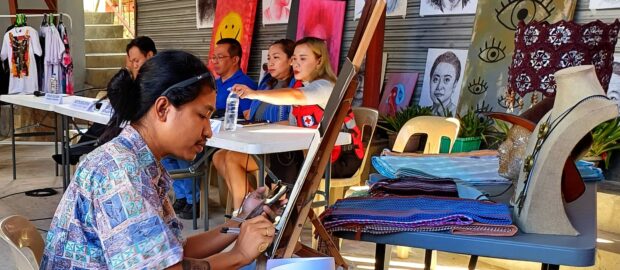Baguio’s neighborhood streets turn into creative markets

ART NOOK In a bid to rejuvenate Baguio City’s creative landscapes across its 128 barangays, young artists initiate Project 2600, which empowers local artisans and transforms barangays into
vibrant creative hubs just like the pilot area in Barangay Camdas. —Photo from Carlito Dar (Contributor)
BAGUIO CITY—Residents of Barangay Camdas opened “pop-up” food stands and displayed upcycled garments at one of their least busiest streets last week to pilot a program that would help activate the creative economies of Baguio’s neighborhoods.
Arvin Molintas, a member of the artist cooperative Baguio Arts and Crafts Collective (Bacci), had been encouraging community weavers, tattoo artists and “waste upcycling” enthusiasts to sell their products along Princess Urduja Street from Jan. 26 to March 3 as part of a “social experiment” that would determine the feasibility of converting interior Baguio villages into community art markets.
Molintas heads the initiative called Project 2600 (the number is the city’s zip code), which has partnered with livelihood consultant Mobile-Oriented Valuable Entrepreneurship to bring incentives and benefits to Baguio artisans, many of whom still operate in the underground economy.
READ: Baguio seeks to address ‘local irritability’ as tourist influx continues
Project 2600 intends to develop “Creative Nooks,” or display and marketing hubs for craftsmen in the city’s 128 barangays.
Article continues after this advertisementAt a briefing on Thursday, Molintas said Bacci, the barangay governments and the Department of Trade and Industry (DTI) would help secure special business permits to legitimize cultural artists in the informal sector, provide them with periodic seminars and workshops on financial management, and tap donors for equipment essential to their crafts.
Article continues after this advertisementMolintas said Project 2600 also engaged various sales platforms, including online trading spaces, to draw the attention of national and foreign customers to authentic artisans in smaller communities and helped the city government and DTI identify and profile the city’s artisan population.
Creative city
Baguio was the country’s first metropolis in the World Creative Cities Network of the United Nations Educational, Scientific and Cultural Organization in 2017, which recognized the “folk art expressions” in the city’s silver craft, woodcarving, tattooing, and weaving. Creative cities are defined by how much their art, culture and traditions have contributed to their economic growth.
Artisans and craft workers of Baguio and the rest of the Cordillera contributed 6.6 percent (P6,651,447,000) to the 2018 gross regional domestic product (P308,267,122,300) of the mountain region, according to former University of the Philippines Baguio Chancellor Raymundo Rovillos, who led a team that measured how culture improved Cordillera’s growth.
Project 2600 planned to engage not just the village of Camdas but also the neighboring barangays of Dizon Subdivision; the East, Lower, Middle and West Quirino Hills; Pinget; and Happy Homes, or the Old Lucban.
He said a weaving community thrives in Camdas and East and West Quirino Hills, while Lower Quirino Hills “creatives” have focused on “more innovative art forms.” Micro-entrepreneurs in Happy Homes invest in food products and other crafts; Pinget artisans produce homemade products like soaps and perfumes; and Dizon Subdivision has tailors who currently produce household rags.
“We don’t want them to settle with rags, so learning from the innovations made by fashion designer Rajo Laurel, we have asked them to generate bags from rags, so it is important we provide them with sewing machines,” he said.
With Camdas as the first community to undertake Project 2600’s “social experiment,” Princess Urduja Street will become the trading space for formerly unlicensed and home-based enterprises, Molintas said.
The stretch of road leads to the project’s first Creative Nook at Camdas’ multipurpose hall, involving members of the art group Pasakalye and other independent artists.
The arts business is volatile, so marketing areas like the Creative Nooks would be helpful for the local art trade, said Adeilada Guia, who used to produce the 10-foot-tall mandalas in 2022 when Session Road closed to traffic. INQ